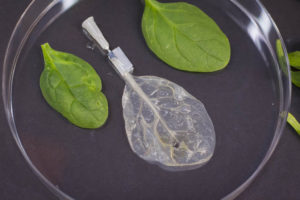
I’m videochatting with Dr. Glenn Gaudette at his biomedical engineering laboratory at the Worcester Polytechnic Institute in Massachusetts, when he swings the camera around to show me his lab’s pride and joy. Ghost-like spinach leaves hang dripping in individual plexiglass chambers. Each one is connected by its stem to something that looks like an IV needle, a syringe that slowly infuses it with detergents, rinsing away its living cells and leaving behind only the vacant cell walls. One day, Gaudette hopes, these decellularized leaves will form the scaffolds for living human heart tissue, a “green” technology for patching damaged hearts.
These spinach leaves aren’t just a potential biomedical breakthrough. They may also hold a clue to solving one of the biggest remaining hurdles in the race to create truly meat-like lab-grown meat. Drawing on the techniques developed in Gaudette’s lab and other related work in the field of regenerative medicine, researchers are attempting to mimic the flavor, form, and texture of meat by growing animal cells on decellularized plants—not just spinach, but celery, artichoke, mushrooms, and jackfruit. Read more